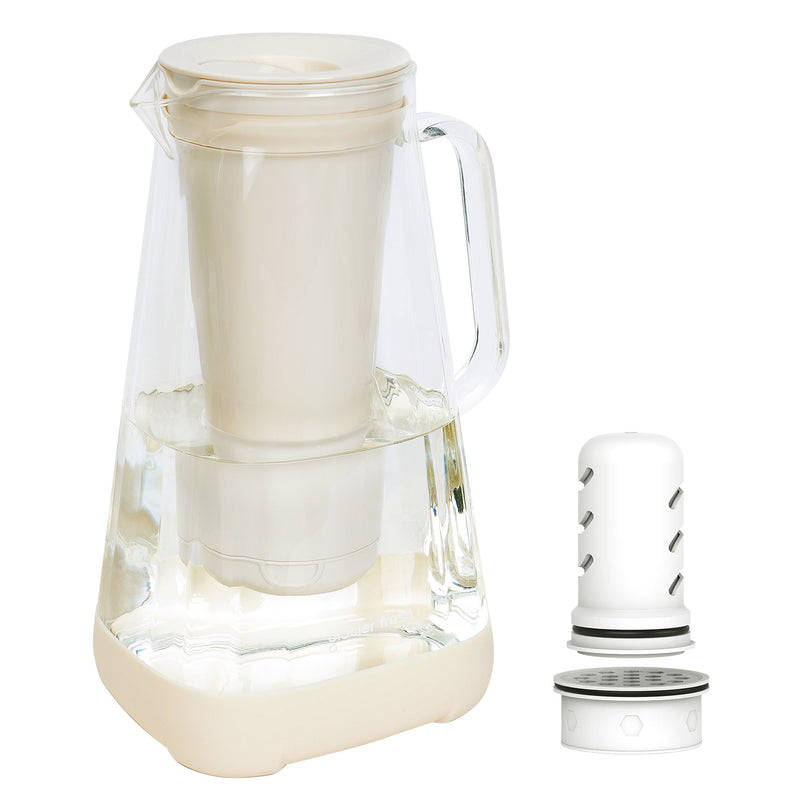Table of Contents:
How much do you know about water filtration?
Types of filtration technologies
The emerging trends in water filtration technology
What`s new in 2024?
Conclusion
Do you know what's new in water filtration technology in 2024? Discover the latest emerging trends and revolutionizing how we filter water. From advanced filtration technologies to innovative breakthroughs, this article will provide valuable insights into cutting-edge developments in the field. Stay ahead of the game and discover how these advancements can improve the quality and safety of your drinking water.
How much do you know about water filtration?

Water scarcity is a pressing issue in many parts of the world, making water filtration essential to ensure clean and safe drinking water. One of the most commonly used methods of water filtration is reverse osmosis. This process involves forcing water through a semi-permeable membrane to remove impurities and contaminants. Reverse osmosis is highly effective in improving water quality and eliminating harmful substances. Water purification is another crucial aspect of water filtration. It involves removing bacteria, viruses, and other microorganisms from water to make it safe for consumption. Different techniques are used for water purification, including disinfection, filtration, and desalination.
There's been a growing emphasis on sustainable filtration methods in recent years. These methods aim to minimize the environmental impact of water filtration processes while still ensuring high-quality results. Sustainable filtration techniques may include using renewable energy sources, such as solar power, and implementing efficient water management practices. Understanding the importance of water filtration and staying informed about the latest technological advancements is crucial for addressing water scarcity and ensuring access to clean and safe water for all.
Types of filtration technologies
Physical filtration

Learn about the different types of filtration technologies used in physical filtration for water treatment in 2024. In this advanced field, novel techniques, materials, and innovative designs are employed to enhance filtration efficiency. Here are four critical areas of focus:
- Nano-filtration: Utilizing advanced materials with nanoporous membranes enables the removal of particles as small as a few nanometers in size, ensuring high-quality water purification.
- Micro-filtration: Using membranes with optimized pore sizes, this technique efficiently removes larger particles, including bacteria and suspended solids, from the water.
- Ultra-filtration: Employing membranes with even smaller pore sizes, this technique effectively eliminates viruses, colloids, and organic matter, making it ideal for water purification in various applications.
- Cross-flow filtration: With an innovative design, this technique allows continuous filtration by maintaining a tangential flow across the filtration surface, reducing fouling and enhancing the overall filtration process.
Biological filtration
To effectively understand the different types of filtration technologies in biological filtration, start by exploring the role of microorganisms in purifying water. Biological filtration relies on using innovative materials and techniques to enhance the sensitivity and efficiency of the filtration process. Here are four types of filtration technologies used in biological filtration:
- Ultrafiltration membranes: These membranes have microscopic pores that allow water to pass through while trapping larger particles and microorganisms. They're highly effective in removing bacteria and viruses from water.
- Smart devices: These devices utilize advanced technology to monitor and control the biological filtration process. They can adjust filtration parameters based on real-time data, ensuring optimal performance and water quality.
- Biofilm reactors: These reactors cultivate a layer of microorganisms on a surface, which helps break down organic matter and remove contaminants from water. They're commonly used in wastewater treatment plants.
- Biological activated carbon: This filtration technology combines activated carbon's adsorption properties with microorganisms' biological activity. It effectively removes organic compounds and improves the taste and odor of water.
Chemical filtration

As you delve into chemical filtration, you'll discover a range of innovative technologies that complement the physical filtration methods discussed earlier. Chemical filtration involves using various techniques to remove impurities and contaminants from water. Key technologies in this field include chemical adsorption, advanced Oxidation, membrane fouling, water desalination, and water disinfection.

These technologies play a crucial role in ensuring the quality and safety of our water supply. They are constantly evolving and improving, contributing to the advancement of water filtration technology.
Ultraviolet radiation technology
Ultraviolet (UV) disinfection is a highly effective method used in water treatment to eliminate waterborne pathogens. UV radiation is employed to achieve microbial inactivation through UVC technology. UV C technology uses short-wavelength UV light to disrupt the DNA structure of microorganisms, preventing them from reproducing and causing harm. This method is particularly effective against bacteria, viruses, and protozoa. The UV radiation penetrates the cell walls of these pathogens, damaging their genetic material and rendering them unable to survive or multiply. UV radiation technology is becoming increasingly popular in water treatment systems due to its high efficiency, low maintenance requirements, and lack of chemicals.
The emerging trends in water filtration technology
Real-time monitoring and automation
You can stay updated on the latest advancements in water filtration technology through real-time monitoring and automation. Here are four key benefits and advantages of implementing these technologies in water filtration systems:
- Real-time monitoring allows continuous tracking water quality parameters such as pH levels, turbidity, and dissolved solids. This ensures that deviations from the desired standards are immediately detected and addressed.
- Automation streamlines the filtration process by eliminating the need for manual intervention. This not only reduces human error but also increases efficiency and productivity.
- Advanced sensor integration enables the collection of vast amounts of data, providing valuable insights into the performance of filtration systems. This data can be analyzed to identify trends, patterns, and potential issues, facilitating predictive maintenance techniques.
- Data-driven decision-making becomes possible through real-time monitoring and automation. With access to accurate and up-to-date information, operators can make informed choices regarding system optimization, resource allocation, and troubleshooting.
Innovative materials and membranes
One exciting development in water filtration technology is using innovative materials and membranes to improve efficiency and effectiveness. Innovative filtration materials and membrane advancements have revolutionized how water is filtered, providing sustainable solutions for improved filtration efficiency. One such advancement is the use of nanomaterials in filtration membranes. These nanomaterials have unique properties that allow for better removal of contaminants and increased water flow rates. Sustainable solutions, such as membranes made from renewable resources or recycled materials, are also being developed.
Improved energy efficiency
With the advancements in innovative materials and membranes, water filtration technology in 2024 focuses on improving its energy efficiency to enhance the performance of filtration systems further and contribute to environmental conservation. Here are four ways in which the industry is achieving this:
- Energy-saving techniques: Water filtration systems are being designed with intelligent controls and sensors to optimize energy usage and reduce wastage.
- Sustainable solutions: Manufacturers are developing eco-friendly innovations such as solar-powered filtration systems and energy recovery systems to minimize the reliance on conventional energy sources.
- Efficient filtration methods: New filtration technologies, like forward osmosis and electrocoagulation, are being employed to achieve high filtration rates while minimizing energy consumption.
- Green technologies: Water filtration systems are incorporating energy-efficient pumps, motors, and valves to ensure minimal energy loss during the filtration process.
Enhanced sensitivity to harmful substances and contaminants
One of the critical advancements in sensitivity enhancement is the development of more accurate contaminant detection techniques. These methods utilize advanced sensors and technologies to identify and quantify different types of contaminants present in water. Additionally, filtration advancements are being made to remove a wide range of harmful substances effectively. These improvements include using advanced filter media and membranes specifically designed to target and remove specific contaminants.
What`s new in 2024?
Ultrafiltration and nanofiltration membranes
You can explore the latest advancements in ultrafiltration and nanofiltration membranes in 2024. Here are four exciting developments in these technologies:
- Ultrafiltration advancements: New ultrafiltration membranes are being developed with enhanced pore sizes and surface properties, allowing for better separation of contaminants from water. These membranes offer improved filtration efficiency and can remove even smaller particles, ensuring cleaner and safer water.
- Nanofiltration applications: Nanofiltration membranes are finding new applications in water treatment processes. They can selectively remove specific ions, such as heavy metals and salts, while allowing beneficial minerals to pass through. This enables the production of tailored water compositions for various industries and ensures better water quality.
- Membrane performance: Researchers are improving the performance of ultrafiltration and nanofiltration membranes. By optimizing membrane structure and surface chemistry, they aim to enhance water permeability and minimize fouling, resulting in a longer membrane lifespan and reduced maintenance costs.
- Membrane durability: Developing more durable membranes is a critical focus in 2024. Scientists are exploring innovative materials and fabrication techniques to enhance membrane strength and resistance to chemical degradation, ensuring long-lasting and reliable water filtration systems.
Smart devices for real-time data collection and analysis
Discover the latest advancement in smart devices for real-time data collection and analysis in 2024. These smart devices revolutionize water quality monitoring by providing accurate, up-to-date information for efficient decision-making. Equipped with advanced sensors, these devices continuously track and analyze water parameters, ensuring the safety and quality of our water supply. Real-time data collection allows for immediate detection of any contaminants or changes in water composition, enabling prompt action to be taken. Integrating data analysis algorithms further enhances the capabilities of these devices, providing valuable insights and predictions.
Automated systems for wastewater treatment plants
The emerging trend in automated systems for wastewater treatment plants in 2024 enhances the efficiency and effectiveness of water quality management. With automatic control and remote operation capabilities, these systems allow for seamless monitoring and adjustment of various treatment processes. Imagine a wastewater treatment plant where every operation is controlled and optimized automatically, ensuring that resources are used efficiently and effectively. Advanced sensors play a crucial role in this trend, providing real-time data on water quality parameters and enabling immediate response to any deviations.
Moreover, energy optimization techniques are employed to minimize the plant's energy consumption, reducing costs and environmental impact. Predictive maintenance is another key feature, allowing proactive identification and resolution of potential issues before they cause disruption. Together, these advancements in automated systems revolutionize wastewater treatment, promoting sustainable and reliable water quality management.
Conclusion
Now you're up to speed on the emerging trends in water filtration technology. With advancements in filtration technologies, 2024 is set to bring even more innovative solutions to ensure clean and safe drinking water. Stay informed to keep up with the latest developments and make the best choices for your water filtration needs.

























